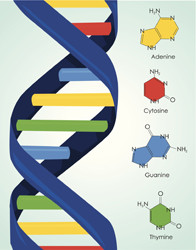Special properties of unusual DNA
DNA is normally a duplex or double-stranded structure. However, some of the building block nucleic acids can form unusual structures such as those with a glut of the base guanine. These form four-stranded nucleic acid structures called G-quadruplexes (G4s) and possess a high degree of plasticity compared to the double-stranded canonical arrangement. Unique properties include polymorphism, robustness and fast folding. These translate into biological functions of importance to disease and ageing – G4s are abundant in the telomere as well as oncogenes and may be important in virus life cycles. The 'Single unusual DNA' (SINGLE UNUSUAL DNA) project has demonstrated a new type of duplex–quadruplex assembly that allowed the unprecedented formation of a trimolecular quadruplex. The researchers used magnetic tweezers to apply forces to the new unusual DNA structures they induced at the picoNewton (pN) scale. They divided a Newton by a million to derive a minute pN of force to induce subtle changes in formation that reveal details of their structure. Using the principle that G-quadruplex formation needs a compatible cation such as sodium (Na+), the team added Na+ to induce the quadruplex formation. Varying the amount of sugar showed that properties of the G-quadruplex rely on ambient concentrations. Moreover, hydroxyl ion concentrations induce position-specific effects. Important for applications, the team also found that they could produce a structure with two different quadruplexes by controlling the incubation buffer and therefore the pH. Such a structure can be turned into a DNA logic gate to study single molecules. Project work has been published in prestigious journals. These include Angewandte Chemie International Edition, Chemical Science, and Chemistry – A European Journal. The work has also been highlighted as a new finding by Faculty of 1000. As G4s are a constituent of biologically important structures, their applications stand to have a significant impact on research and medical fields. Therapies for chronic diseases as a result of ageing and cancers could be among them.







